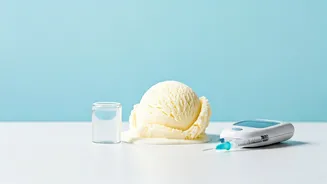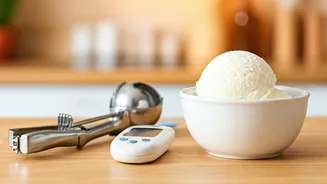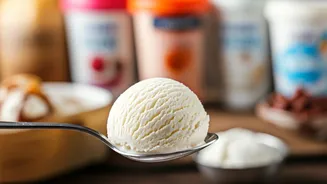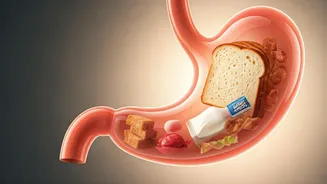Ice Cream and Diabetes
For those with diabetes, enjoying ice cream requires careful consideration due to its potential impact on blood sugar levels. Regular ice cream, packed
with sugar and carbohydrates, can cause significant spikes in blood glucose. However, it's not about complete deprivation; rather, it’s about making informed choices. Understanding how different types of ice cream affect your body is the first step. This knowledge empowers you to make decisions that align with your health goals. The key is to recognize that not all ice creams are created equal and that moderation is a cornerstone of managing diabetes. By focusing on portion control, ingredient awareness, and strategic timing, individuals with diabetes can still savor this beloved dessert without causing adverse effects on their health. This approach encourages a balanced lifestyle where treats can be enjoyed responsibly.
Blood Sugar Impact
The primary concern with ice cream for people with diabetes is its effect on blood sugar levels. Traditional ice cream contains a high concentration of carbohydrates and sugars, which are quickly converted into glucose in the bloodstream. This rapid influx of glucose can lead to hyperglycemia, or high blood sugar. The severity of this response varies depending on the type and quantity of ice cream consumed, as well as individual factors like metabolism and insulin sensitivity. To mitigate this effect, it's essential to monitor blood sugar levels regularly, especially after consuming ice cream. This can help you understand how your body reacts and allow you to make necessary adjustments to your diet or medication. Considering the Glycemic Index (GI) and Glycemic Load (GL) of ice cream is crucial, with lower GI options generally causing a slower rise in blood sugar.
Smart Consumption Tips
To enjoy ice cream safely, several strategies can be employed. Firstly, portion control is paramount. Opting for smaller servings helps limit the amount of sugar and carbohydrates consumed. Secondly, choosing ice cream with lower sugar content is beneficial. This could include no-sugar-added varieties or those sweetened with alternatives. Thirdly, it is critical to pair your ice cream with foods that can help slow the release of glucose into the bloodstream, such as high-fiber options or foods rich in protein and healthy fats. Consuming ice cream after a meal that contains these elements is also advisable. Furthermore, be mindful of the timing; consuming ice cream at a time when you are less likely to experience a significant blood sugar spike can be useful. Regularly check your blood glucose levels after eating to see how your body responds.
No-Sugar-Added Options
The availability of no-sugar-added ice cream offers an excellent alternative for people with diabetes. These options generally replace sugar with artificial sweeteners or sugar alcohols, which have a less dramatic impact on blood sugar. However, it is essential to review the nutrition label of these products carefully, as they might still contain carbohydrates from other ingredients. Some no-sugar-added ice creams may also use high amounts of fat to maintain the taste and texture of regular ice cream. This can affect your overall health and well-being. Look for products that are low in both sugar and saturated fat. Always consider the serving size and how it aligns with your daily carbohydrate intake. Keep in mind that artificial sweeteners may cause digestive issues in some people, so monitoring your body's response is essential.













